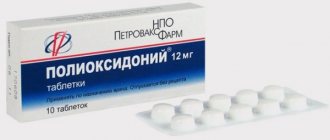Release form and composition
Zovirax is available in the following dosage forms:
- Cream for external use 5%: homogeneous, almost white or white (2 g in plastic bottles with a dispensing device, 2, 5 or 10 g in aluminum tubes, 1 bottle or tube in a cardboard box);
- Eye ointment 3%: translucent, almost white or white, oily, soft, homogeneous without lumps, grains or foreign particles, with a characteristic faint odor (4.5 g in tubes with a polyethylene nozzle, 1 tube in a cardboard box);
- Lyophilisate for preparing a solution for infusion: sintered mass (porous cake) or hygroscopic powder of almost white or white color (250 mg in glass bottles, 5 bottles in plastic trays, 1 tray in a cardboard box);
- Tablets: biconvex, round, white, with the inscription “GXCL3” on one side (5 pieces in strip packs, 5 packs in a cardboard box).
The composition of 1000 mg cream for external use includes:
- Active substance: acyclovir – 50 mg;
- Auxiliary components: liquid paraffin, propylene glycol, soft white paraffin, cetostearyl alcohol, sodium lauryl sulfate, poloxamer 407, dimethicone, glycerol monostearate, macrogol stearate, purified water.
The composition of 1000 mg eye ointment includes:
- Active substance: acyclovir – 30 mg;
- Auxiliary component: white Vaseline.
The composition of 1 bottle with lyophilisate for preparing a solution for infusion includes:
- Active substance: acyclovir – 250 mg;
- Auxiliary component: sodium hydroxide.
1 tablet contains:
- Active substance: acyclovir – 200 mg;
- Auxiliary components: lactose monohydrate, sodium starch glycolate, povidone K30, magnesium stearate, microcrystalline cellulose.
Interaction
No significant drug interactions were detected when using the drug.
Acyclovir is excreted unchanged into the urine due to tubular secretion . All drugs with a similar method of elimination can increase the concentration of acyclovir in the blood.
Caution should be exercised in combining intravenous administration of Zovirax with drugs that interfere with kidney function ( Ciclosporin , Tacrolimus and others).
Indications for use
Zovirax in the form of a topical cream is prescribed for the treatment of infections of the skin and mucous membranes caused by herpes simplex virus types 1 and 2, including herpes labialis.
Eye ointment is used for keratitis caused by herpes simplex virus types 1 and 2.
Zovirax orally and in the form of a solution for infusion is used in the presence of the following indications:
- Treatment of infections caused by the Varicella zoster virus (herpes zoster and chickenpox);
- Prevention of infections caused by herpes simplex virus types 1 and 2 in patients with immunodeficiency.
The solution for infusion is also used in the treatment of infections caused by herpes simplex virus types 1 and 2 (including neonates) and for the prevention of cytomegalovirus infection in bone marrow transplant recipients.
Additional indications for taking Zovirax in tablet form are:
- Treatment of infections of the mucous membranes and skin caused by herpes simplex virus types 1 and 2, including genital herpes (primary and recurrent);
- Treatment of patients with severe immunodeficiency (mainly with a full-blown clinical picture of AIDS, with HIV infection (with CD4+ cell count <200/μl), with early clinical manifestations of HIV infection) who have undergone bone marrow transplantation;
- Prevention of relapse of infections caused by herpes simplex virus types 1 and 2 in patients with normal immune status.
What are the therapeutic properties of Zovirax skin cream and eye ointment?
The active substance of the drug has the ability to inhibit the replication of herpes simplex viruses (HSV) of all types, Varicella zoster, cytomegalovirus and Epstein-Barr. Acyclovir has the most pronounced antiviral properties against the herpes virus type 1.
After the first application of Zovirax to an area of the skin damaged by infection, acyclovir is not absorbed into the blood. With subsequent uses, the amount of absorption of the active ingredient into the bloodstream is minimal.
Contraindications
The use of Zovirax in all dosage forms is contraindicated in the presence of hypersensitivity to the components of the drug, as well as to valacyclovir.
For lactating and pregnant women, the drug can be used only in cases where the benefit to the health of the mother is higher than the possible risk to the child or fetus.
When administering intravenously and taking Zovirax orally, caution should be exercised in patients with renal failure and in patients with signs of dehydration. Additionally, the solution for infusion should be administered with caution during the development of reactions to cytotoxic drugs when administered intravenously (and if there is a history of such reactions), as well as in the presence of neurological disorders.
During pregnancy
It is allowed to use Zovirax tablets, solution, as well as cream and ointment if a woman has an interesting situation and during breastfeeding, but with extreme caution, if indicated and if the expected benefit to the mother outweighs the risk to the fetus. According to studies, there was no increase in the number of congenital diseases in children whose mothers took the drug during pregnancy.
Directions for use and dosage
The cream for external use is recommended to be applied in a thin layer to the affected and surrounding areas of the mucous membranes and skin 5 times a day (at intervals of 4 hours). To avoid additional infection of the affected areas, Zovirax should be applied with clean hands or a cotton swab.
The duration of therapy is at least 4 days. If there is no effect, the duration of the course can be increased to 10 days. If symptoms persist for more than 10 days, you should consult your doctor.
An eye ointment strip 1 cm long is placed in the lower conjunctival sac. The drug is used 5 times a day (with 4 hours between applications). After healing, treatment should be continued for another 3 days.
Zovirax solution is intended for intravenous infusion.
For adults, when treating infections caused by the Varicella zoster and Herpes simplex viruses (except herpetic encephalitis), Zovirax is prescribed every 8 hours, 5 mg/kg body weight.
For infections caused by the Varicella zoster virus and herpetic encephalitis in patients with immunodeficiency with normal renal function, intravenous infusions are administered every 8 hours at a dose of 10 mg/kg body weight.
During bone marrow transplantation for the prevention of cytomegalovirus infection, Zovirax is used 3 times a day (with 8-hour breaks) at a dose of 500 mg/m² of body surface. The duration of therapy is from 5 days before transplantation and up to 30 days after it.
Obese patients are recommended to use the same doses as patients with normal body weight.
In patients with renal failure, the dosage regimen must be adjusted in accordance with creatinine clearance:
- 25-50 ml per minute: every 12 hours 5-10 mg/kg or 500 mg/m²;
- 10-25 ml per minute: every 24 hours 5-10 mg/kg or 500 mg/m²;
- Less than 10 ml per minute (including anuria): every 24 hours, 2.5-5 mg/kg or 250 mg/m² (for continuous ambulatory peritoneal dialysis).
During hemodialysis, the drug is administered every 24 hours and after dialysis at 2.5-5 mg/kg or 250 mg/m².
Doses of Zovirax for intravenous infusion for children from 3 months to 12 years are set individually depending on the body surface area.
The dosage regimen for newborns is set depending on body weight. The recommended dose for the treatment of infections caused by Herpes simplex virus types 1 and 2 is 10 mg/kg every 8 hours. The duration of therapy for herpetic encephalitis and infections caused by the Herpes simplex virus is usually 10 days. For infections caused by the Varicella zoster and Herpes simplex viruses (except for herpetic encephalitis), Zovirax is administered every 8 hours at 250 mg/m².
In children with immunodeficiency (with normal kidney function) in the treatment of herpetic encephalitis and infections caused by the Varicella zoster virus, the drug is administered every 8 hours at 500 mg/m².
For children over 2 years of age who have undergone bone marrow transplantation, Zovirax can be administered in adult doses to prevent cytomegalovirus infection.
For children with reduced renal function, doses should be adjusted according to the degree of renal impairment.
Elderly patients with reduced creatinine clearance may require a dose reduction.
As a rule, the course of treatment with Zovirax in the form of intravenous infusions is 5 days, however, depending on the patient’s condition and response to therapy, it may vary. The duration of prophylactic use of Zovirax is determined by the duration of the period of existence of the risk of infection.
The recommended dose of Zovirax should be administered over 1 hour as a slow intravenous infusion.
To prepare the solution, use water for injection or 0.9% sodium chloride solution for injection at the rate of every 25 mg of the drug per 1 ml of dilution solution (add to the ampoule with the powder and shake gently until the powder contained in the ampoule is completely dissolved ).
The resulting Zovirax solution is administered using a special infusion pump that regulates the rate of its administration. Another method of administration is possible, in which the prepared solution is diluted to obtain an acyclovir concentration not higher than 5 mg/ml (0.5%).
Zovirax in tablet form is taken orally with water (200-250 ml). The drug can be taken with food (eating does not significantly interfere with its absorption).
The recommended adult single dose of Zovirax in tablet form for the treatment of infections caused by Herpes simplex virus types 1 and 2 is 200 mg. The drug is taken 5 times a day, taking breaks of 4 hours (except for the period of night sleep). As a rule, the duration of the therapeutic course is 5 days; in case of severe primary infections, it can be extended.
If absorption from the intestine is impaired or in the presence of severe immunodeficiency (for example, after bone marrow transplantation), the single dose of Zovirax can be increased to 2 tablets (400 mg). After infection occurs, therapy should be started as early as possible. If relapses occur, it is recommended to start taking the drug when the first elements of the rash appear or in the prodromal period.
In patients with normal immune status, to prevent relapses of infections caused by Herpes simplex virus types 1 and 2, Zovirax is taken every 6 hours (4 times a day) 1 tablet. It is also possible to use the drug 2 times a day (every 12 hours) 2 tablets (400 mg). Sometimes lower doses of Zovirax are effective: 3 times a day (with a break of 8 hours) 1 tablet or 2 times a day (with a break of 12 hours). Periodically, therapy should be interrupted for 6-12 months to identify possible changes in the course of the disease.
For patients with immunodeficiency, to prevent infections caused by the Herpes simplex virus types 1 and 2, Zovirax is recommended to take 1 tablet 4 times a day (every 6 hours). If absorption from the intestine is impaired or in patients with severe immunodeficiency (for example, after bone marrow transplantation), it is possible to increase the single dose by 2 times (400 mg) and the frequency of taking the drug up to 5 times a day. The duration of the preventive course of treatment is determined by the duration of the period of existence of the risk of infection.
When treating herpes zoster and chickenpox, Zovirax is prescribed 5 times a day (every 4 hours, except during night sleep), 4 tablets. The duration of the therapeutic course is 7 days.
After the onset of infection, Zovirax should be prescribed as early as possible, since in this case the therapy is more effective.
The recommended single dose for severe immunodeficiency is 4 tablets, the frequency of administration is 4 times a day (every 6 hours).
After bone marrow transplantation, before using Zovirax orally, it is usually recommended to conduct a course of intravenous therapy with acyclovir for 1 month. Clinical studies have found that the maximum duration of therapy for bone marrow transplant recipients was 6 months. In patients with an advanced clinical picture of HIV infection, the duration of treatment was 12 months, but longer courses of therapy may be effective.
For children with immunodeficiency aged 2 years and older, for the treatment and prevention of infections caused by Herpes simplex viruses, Zovirax is prescribed in adult doses; for younger children, the dose should be reduced by 2 times.
A single dose for children over 6 years of age for the treatment of chickenpox is 4 tablets; from 2 to 6 years – 2 tablets; under 2 years – 1 tablet. The frequency of taking the drug is 4 times a day. More precisely, a single dose is determined at the rate of 20 mg/kg body weight (but not more than 4 tablets). The course of therapy is 5 days.
There is no data on the effectiveness of Zovirax in the treatment of herpes zoster and for the prevention of relapses of infections caused by Herpes simplex viruses in children with normal immunity.
According to the very limited information available, when treating children over 2 years of age with severe immunodeficiency, the same doses of Zovirax can be prescribed as for adults.
When prescribing the drug to elderly patients, the possibility of a decrease in the clearance of acyclovir simultaneously with a decrease in creatinine clearance should be taken into account. If there are signs of renal failure, a dose reduction of Zovirax should be considered. When taking high doses of the drug orally, elderly patients need to drink enough fluids.
In patients with renal failure, taking the drug orally in recommended doses for infections caused by Herpes simplex viruses (for treatment and prevention) does not lead to the accumulation of the active substance to concentrations exceeding established safe levels. However, if the creatinine clearance is less than 10 ml per minute, the dose of Zovirax must be reduced to 1 tablet 2 times a day (with breaks of 12 hours). In the treatment of herpes zoster, chickenpox, as well as for the treatment of patients with severe immunodeficiency with creatinine clearance less than 10 ml per minute, the recommended doses of Zovirax are 4 tablets 2 times a day (with breaks of 12 hours); with creatinine clearance 10-25 ml per minute - 4 tablets 3 times a day (with breaks of 8 hours).
For children
According to the instructions for use, young patients with immunodeficiency are prescribed the drug according to age:
- Up to two years of age, use half the dosage for adults.
- Children from two years of age are prescribed doses as for adults.
According to the instructions for Zovirax, children are prescribed it in the following dosages:
- Children under two years of age are prescribed 200 milligrams of the drug four times a day.
- For young patients from two to six years old, the medicine is recommended four times a day, 400 mg.
- Children from six years of age are prescribed medication four times a day, 800 milligrams.
The most accurate dosage can be determined based on the patient’s weight: 20 mg per kilogram of body weight four times a day. The duration of therapy is 5 days.
According to the instructions for use, it is known that eye ointment and cream are used in children according to the same scheme and in the same concentrations as in adult patients. Dosages of lyophilisate for intravenous use in children from three months to twelve years are calculated based on the area of the skin.
When eliminating infectious lesions that are associated with the herpes simplex and herpes zoster virus, the dosage of intravenous injections is calculated according to the scheme of 250 milligrams per square meter three times a day.
Side effects
When using Zovirax in the form of an external cream, the following side effects may develop:
- Allergic reactions: rarely - allergic dermatitis (in most cases, such disorders are associated with a reaction to excipients); in some cases - Quincke's edema;
- Local reactions: sometimes - short-term itching, redness, peeling, tingling or burning in areas where the cream is applied.
When using eye ointment, the following problems may occur:
- Organ of vision: often – a slight burning sensation that transient over time; sometimes - conjunctivitis, punctate superficial keratopathy (disappears without consequences, cessation of treatment is not required); rarely – blepharitis;
- Allergic reactions: very rarely - immediate hypersensitivity reactions (including angioedema).
When administered intravenously and taken orally, Zovirax may develop side effects from certain body systems:
- Central nervous system: reversible neurological disorders, including hallucinations, confusion, tremor, agitation, psychosis, drowsiness, coma and convulsions (as a rule, these disorders occur in patients with renal failure who take the drug in excess of recommended doses);
- Digestive system: vomiting, nausea, reversible increase in the activity of liver enzymes and bilirubin levels; very rarely - jaundice, hepatitis;
- Urinary system: rarely - increased levels of creatinine and urea in the blood (to avoid this, the solution should be administered as a slow infusion over 1 hour and the fluid balance of patients should be maintained); very rarely - acute renal failure;
- Hematopoietic system: anemia, thrombocytopenia and leukopenia;
- Allergic reactions: photosensitivity, rash, urticaria, fever, itching; rarely - angioedema, shortness of breath, anaphylaxis.
If Zovirax solution gets under the skin, severe inflammatory reactions may occur, causing necrosis.
When taking the drug in tablet form, it is also possible to develop rapid fatigue, and in rare cases, rapid diffuse hair loss may occur (no connection with Zovirax has been established).
In patients receiving antiretroviral drugs, additional use of Zovirax does not cause a significant increase in toxic effects.
Overdose
There is no information about an overdose of the drug in the form of a cream or eye ointment.
Overdose of pills
With a single random oral dose of up to 20 grams, no undesirable effects are recorded.
Signs of overdose: nausea, vomiting, headache, shortness of breath, confusion, renal dysfunction, diarrhea , convulsions , lethargy , coma .
Careful observation is necessary in order to timely identify possible signs of intoxication. of hemodialysis cannot be ruled out .
Overdose with solution
Signs of overdose: increased levels of urea nitrogen and creatinine in the blood, hallucinations, renal failure , confusion, convulsions , agitation, coma .
Hemodialysis is recommended , which significantly enhances the evacuation of acyclovir from the body and is the optimal method of treatment for overdose of injectable forms of Zovirax.
special instructions
In case of severe manifestations of herpes lips, it is recommended to consult a doctor.
To achieve maximum effect, Zovirax should be applied externally when the first signs of the disease appear (itching, tingling, burning, redness and a feeling of tension). The drug should not be applied to the mucous membranes of the eyes and mouth, as this can lead to the development of local inflammation.
If you have genital herpes, you should avoid sexual intercourse or use condoms, since the use of the drug does not prevent sexual transmission of the virus.
Patients with immunodeficiency should adhere to the doctor's recommendations when treating any infectious diseases.
After using Zovirax in the form of an eye ointment, a slight burning sensation may occur, which goes away on its own. You should not wear contact lenses during therapy.
Patients with herpetic encephalitis receiving high doses of Zovirax by infusion should monitor renal function (especially if there is initial impairment of renal function or dehydration).
Zovirax should be used with caution, monitoring the functional state of the kidneys, concomitantly with drugs that impair renal function (for example, tacrolimus, cyclosporine).
The prepared Zovirax solution has a pH of 11, so it cannot be taken orally.
Patients using high doses of the drug in tablet form should drink enough liquid.
How to store Zovirax at home
When storing drugs from the Zovirax group, we recommend following the recommendations given by the drug developers:
Store out of the reach of children at a temperature not exceeding +25 degrees; for ampoules in packaging up to +30 is allowed. The place should be protected from direct sunlight and dry.
Can it be stored in the refrigerator and freezer?
Zovirax does not require storage in the refrigerator, but it can be stored in a side shelf. Storage in the refrigerator is prohibited.
What storage conditions is the drug Zovirax “afraid of”?
The medication may deteriorate faster if left in a place where the sun regularly shines (even through glass), and it is also adversely affected by moisture and dampness. Low and too high temperatures (below zero and above thirty degrees) negatively affect the condition of the drug.
Analogue drugs:
Acyclovir
Chicken pox
Chicken pox (popularly known as chickenpox) is a virus that affects absolutely every person, mainly in childhood.
You can become infected with it either through airborne droplets or through contact with an infected person. A sign of the disease is a rash (small blisters with liquid) all over the body, severe itching, and occasionally fever. When scratching them, small wounds and ulcers may form, in which pus can form. For this reason, the first step is to get rid of the rash. Rashes cause a lot of discomfort to children, because they cannot restrain themselves from scratching (as a result, a bacterial infection of the epithelium may appear). Everyone knows the traditional method of treating chickenpox: regularly smear each pimple with brilliant green and wait for a crust to appear. Now this method does not seem very appropriate. Doctors recommend using an ointment that has a triple effect: antiviral, drying and healing. Zovirax is just such a drug, used for children.





